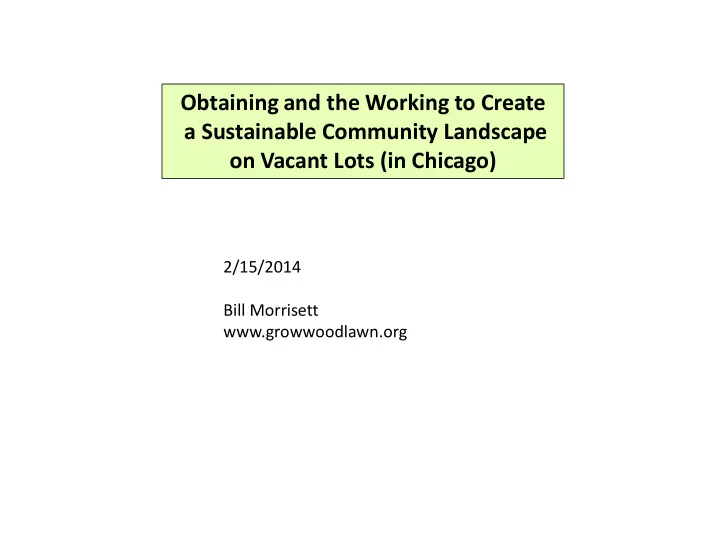

Obtaining and the Working to Create a Sustainable Community Landscape on Vacant Lots (in Chicago) 2/15/2014 Bill Morrisett www.growwoodlawn.org
West Woodlawn – 63 rd to 65 th , Eberhart to Cottage Grove
Vacant Lots Possibilities • Landscaping - Small, low-maintenance patches of landscaping in a lot, or a larger-scale project. • Food growing - community garden or urban agriculture. • Extras - Paths, benches, outdoor art, dog area • Mix and match – combine landscaping, food growing, art, etc.
Vacant Lot Project Steps Steps 1. Select and secure a lot 2. Organize, set goals, design space 3. Make a plan (costs, resources, timeline) 4. Implement the plan
Who Owns the Lot? 1. Chicago City Owned Land Inventory (spreadsheet) (Menu > Download > select file type) 2. CookViewer 3. Cook County Recorder of Deeds • 1 st Grantee: Chicago. This lot is city-owned. • If not a city-owned lot, for $2.50 you can download a deed document that has owner’s name and address.
Water Irrigation – drip lines, sprinkler Ellis View, rain barrels system Tamper-proof Cap Hose Protection Ramp 275 gallon ICB Tote Water from a building Rainwater Catchment System Draught Tolerant Plants Can you use rainwater from a roof to grow food? Careful testing recommended! Humboldt State University, appropedia.org
Secure The Lot • City-owned • Privately owned • NeighborSpace – land trust
COMMUNITY Gardening • Start • Keep it going • Make it fun – weekly social hour – monthly – end of season harvest celebration – kids events
Planning Process • The ‘No - Plan’ Plan • Bottom Up • Top Down
Community Garden Organization One model for a community garden organization (on a city-owned lot)
-Growing Food- Plot Assignments and Garden Rules 62 nd & Dorchester Allotment . Plots are individually ‘owned’ for a season Shared Effort and Shared Harvest . Shared Effort and Food Pantry Much or all of the garden space is Harvest . The gardening effort is worked together, and those shared and the produce goes contributing to the effort harvest mostly to food pantries, etc. what they need for their family.
Chicago Urban Agricultural Ordinance • Urban Farm. For-profit or non-profit. Grows food to be sold. • Community Garden. Maintained by volunteers. Plants grown are intended for personal use, for charity, or community beautification. Selling surplus harvest is allowed “if the sales are accessory or subordinate” in purpose. Growing Home Wood Street Urban Farm growinghomeinc.org Community garden max size: 25,000 sq. ft. (100’ x 250’ for example) 62 nd & Dorchester Community garden
Soil and Compost Compost delivery • Check for rubble • Soil test: plant nutrients, lead, other heavy metals. Univ. Mass. Amherst, StatAnalysis (local) • Avoid trucking in soil • Fruits & Vegetables – 12” to 24” of compost. Dwarf apple, raspberry, blackberry possible. • Ornamentals – raised beds (planters), berms, ‘rubble holes’.
Raised Beds Rebuilding Exchange – used lumber. Hard wood and ‘Old wood’ last longer. 2”x 12” boards work well. Avoid treated wood and plywood! Reduce rotting of wood sides: Brick footings, plastic on inside wall. Mozart’s Garden, 800 N Mozart
source: Schreiber Park Ruby Garden, Rogers Park, www.therubygarden.com
Community Garden - Implementation source: Schreiber Park Ruby Garden, Rogers Park, www.therubygarden.com
Resources for a Vacant Lot Project • Connecting Chicago Community Gardens (CCCG) • Neighborhood gardening organization • Openlands • NeighborSpace • Chicago Cares • University community service programs
Community Greening/Art Projects Where Vacant lot (city or private), school, park, residential block, business block. What Grow food, landscaping, paths, benches, pergola, topiary, pots, planters, raised beds, tool shed, water cistern, irrigation system, compost bins, barbecue/fire pit, outdoor art (DIY wood, concrete, mosaics, murals, blacktop painting – map/art/line games) Who Block club, church group, school, social services organization (ex-offender program, juveniles-at-risk, etc.), FOTP, business sponsor
Mosaic Stepping Till Learning Garden 65 th & Woodlawn Brickyard Garden Stone Project 62 nd & Dorchester 62 nd & St. Lawrence 65 th Place & Blackstone William Hill Sculpture Garden 60 th & St. Lawrence
Parkway Planters 5600 – 5900 N Ridge 1300 W. Devon in Winter Planters are maintained by Edgewater Triangle Neighbors Assoc. (ETNA) Contact Susan Darnall to volunteer.
Contact Info: Bill Morrisett morrisett@midwestcyber.com
Recommend
More recommend